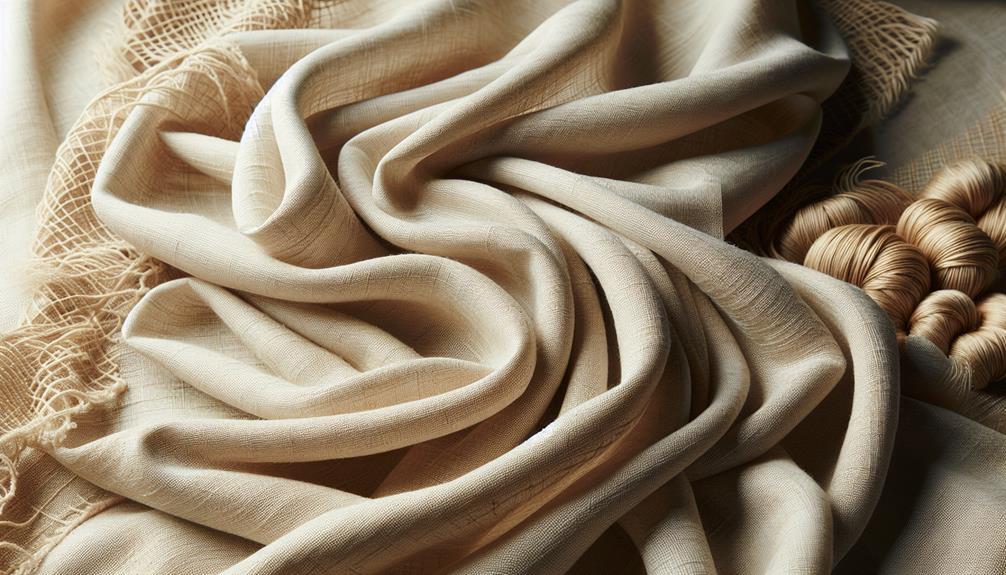So, you're curious about whether 100% linen is really worth the hype, huh? I've been exploring this topic for a while, and honestly, there's a lot to unpack. Linen's got this fantastic reputation for being durable, breathable, and even eco-friendly, which is a big plus in my book. But, is it all sunshine and rainbows? From its unique comfort in scorching temperatures to its timeless style, linen seems like a no-brainer. Yet, I can't help but wonder about its quirks, like the infamous wrinkling. Stick around, and let's figure out if linen truly stands up to its esteemed status.
Table of Contents
Key Takeaways
- 100% Linen is highly durable, outlasting cotton when properly cared for.
- Offers exceptional comfort and breathability, making it ideal for hot weather.
- Features moisture-wicking properties to keep you dry and comfortable.
- Hypoallergenic, benefiting sensitive skin and reducing allergic reactions.
- Sustainable, with a minimal environmental footprint compared to other fabrics.
Understanding Linen Fabric
Linen's a lightweight, super durable fabric made from the flax plant, and it's known for being the strongest natural fiber out there. What's really cool is how this stuff comes from flax, which is basically the champ of natural fibers, making linen two to three times stronger than cotton. Think about it – that's some serious durability we're talking about.
Now, when folks get into the nitty-gritty of fabrics, thread count often pops up. It's a bit different with linen. You see, because of its natural thickness and strength, a high thread count isn't the be-all and end-all. Instead, the quality of linen is more about the feel and the weave. This doesn't mean thread count's irrelevant, but it's not the sole indicator of quality like with some other fabrics.
And here's the kicker – linen's not just tough; it's also quick-drying and super breathable, making it a go-to for beating the heat. Plus, it's antibacterial and hypoallergenic. So, for anyone aiming to master their understanding of fabrics, getting why linen stands out, especially its roots in flax and the whole thread count story, is key.
Linen Vs. Cotton Comparison
Having covered why linen stands out, let's compare it with cotton and see how it stacks up. Diving into the linen vs cotton debate, it's clear both have their merits, but linen fabric holds a few aces up its sleeve. Here's a quick rundown:
- Absorbency and Quick-Drying: Linen outperforms cotton here. It's a champ at soaking up moisture and dries super fast, which is a godsend in sweaty situations or humid climates.
- Temperature Regulation: Thanks to its higher heat conductivity, linen keeps you cool when it's hot and snug when it's not. Cotton can't quite match this adaptability, making linen the go-to for year-round comfort.
- Strength and Durability: Linen fabric is the heavyweight champion, stronger and more durable than cotton. This means your linen items not only last longer but actually get better with age. Talk about a good investment!
- Environmental Impact: Linen has a greener footprint, using way less water and more sustainable farming practices compared to cotton.
Durability and Longevity
One of the biggest wins for linen is its impressive durability, outlasting cotton by years with the right care. Let's get this straight: when you invest in linen, you're not just buying a fabric; you're signing up for a long-lasting relationship. The thing is, linen's strong fibers are the real MVPs here. They're like the unsung heroes behind its resilience and longevity.
Now, I've seen cotton items wear out faster, especially with frequent washing. That's not the case with linen. It's like the more you wash it, the better it gets, without losing its strength. And talking about maintenance, it's no rocket science. A bit of proper care, and you're set to see your linen pieces age like fine wine.
Comfort and Breathability
Why settle for less when you can stay cool and comfy in linen, the champ of breathability and comfort in the heat? Let's dive into why linen, made from the flax plant, is your go-to for those scorching days.
First off, linen's got this incredible knack for ventilation. Its structure, a bit looser with a high thread count, allows air to flow freely, making it feel like you're wearing your own personal breeze.
Here's the scoop on why linen is the MVP when the mercury rises:
- Superior Ventilation: Linen lets your skin breathe like no other fabric, keeping you cool even when it's blazing outside.
- Top-notch Comfort: Its natural fibers provide a soft, luxurious feel that just gets better with time.
- Unmatched in Hot Weather: Linen is hands down the most comfortable fabric for beating the heat.
- Elegance and Ease: It embodies that laid-back, Mediterranean vibe, making you look good without trying too hard.
Moisture-Wicking Properties
Linen's knack for soaking up moisture without leaving you feeling damp is a game changer in sweaty situations. Here's the deal: when it comes to moisture-wicking properties, linen is a rockstar. It's not just about absorbing water; it's how fast linen does it compared to cotton. While you're out there, getting your hustle on in the heat, linen's working overtime to pull perspiration away from your skin. This fabric isn't just absorbing water; it's practically inhaling it, capable of gaining up to 20% of its dry weight in moisture.
What's more, linen doesn't just trap this moisture. Unlike cotton, which can leave you feeling like you're wrapped in a damp towel, linen dries out super fast. This means you stay comfortable and, more importantly, dry. It's perfect for those hot and humid days when you need your clothing to work as hard as you do. The cool and fresh sensation linen provides isn't just a luxury; in many ways, it's a necessity. So, yeah, when it comes to beating the heat and staying dry, linen's moisture-wicking properties are pretty much a game changer.
Hypoallergenic Benefits
Moving on from its moisture-wicking superpowers, let's talk about how 100% linen steps up as a hypoallergenic hero.
It's a game changer for folks like me with sensitive skin, reducing allergic reactions and being super gentle on the skin.
Plus, its natural antimicrobial properties mean less worry about skin irritations, making it a top pick in my book.
Reduces Allergic Reactions
For folks with sensitive skin, linen's hypoallergenic qualities can really make a difference, cutting down on allergic reactions and skin irritations. Here's why I'm all in on linen for keeping those pesky allergies at bay:
- Linen doesn't give dust mites a place to call home, which is a big win for allergy sufferers.
- Its natural antibacterial properties are a game-changer, keeping skin reactions to a minimum.
- The fabric's breathability and ability to wick moisture keep your skin dry and less prone to irritation.
- Even hospitals are on the linen bandwagon, using it to protect patients with sensitivities.
Linen's hypoallergenic nature isn't just a bonus; it's a necessity for those of us looking to dodge allergies and skin irritations.
Natural Antimicrobial Properties
Building on its allergy-fighting qualities, linen also boasts natural antimicrobial properties that further benefit those with sensitive skin. You know, it's not just about keeping the sneezes at bay. This fabric is a warrior against bacteria buildup, odors, and those annoying skin irritations that can make your day go from great to 'why me?' real quick.
Linen's like the superhero of fabrics for anyone who's ever felt betrayed by their own skin. Its hypoallergenic benefits aren't just talk; they're about making your environment—a.k.a., where you sleep, wear, and live—cleaner and fresher. Opting for 100% linen isn't just choosing fabric; it's choosing a natural ally in promoting skin health and overall well-being. Trust me; it's worth considering.
Gentle on Skin
As someone with sensitive skin, I've found that linen's hypoallergenic qualities are a game changer, offering a soft touch without triggering irritations or allergies. It's all about the natural fibers, which are smooth and seem to treat my skin with kid gloves. Here's why I'm all in on linen:
- Gentle on Sensitive Skin: Perfect for avoiding those pesky irritations.
- Hypoallergenic: No more sneezes or itchy moments.
- Ideal for Skin Conditions: Eczema or dermatitis sufferers, rejoice!
- Breathable & Moisture-Wicking: Keeps your skin happy and dry.
Honestly, it's no wonder hospitals are big on linen too. It's not just about comfort; it's about skin health. Linen's just got that gentle, hypoallergenic hug your skin's been longing for.
Linen for Hot Climates
So, let's talk about why I'm convinced that linen is the MVP for hot climates.
First off, its breathability and moisture-wicking abilities keep you feeling cool and dry, which is a game-changer when the heat is on.
Plus, linen's durability means it can handle the high temps without breaking a sweat.
Breathability and Comfort
When you're dealing with scorching temperatures, nothing beats the comfort and breathability of 100% linen fabric. I've found that in the battle against the heat, linen is my go-to because of several key features:
- Natural fibers that allow air to flow freely, making it super breathable.
- The unique structure of linen fibers offers a cool touch, essential for staying comfortable in the heat.
- It's not just about staying cool; linen also regulates body temperature efficiently, ensuring I'm not just cool but comfortable.
- Compared to cotton, linen's breathability is unmatched, making it the superior choice for summer wear.
In my experience, linen's unmatched breathability and comfort make it the ultimate fabric for anyone wanting to beat the heat in style.
Moisture-Wicking Properties
Linen's got this amazing knack for wicking moisture away, which is a game-changer in hot weather. Seriously, this natural textile isn't just about looking good; it's about keeping you cool, dry, and comfortable when the heat is on. Thanks to its top-notch moisture-wicking properties, linen pulls sweat off your skin and lets it evaporate fast. This means you're not stuck feeling damp and sticky, unlike when you're wearing some other fabrics, like cotton.
What's the big deal here? Well, in scorching climates, wearing linen can actually make a huge difference. It absorbs and releases moisture quicker than a magician, ensuring you stay fresh all day. For anyone wanting to beat the heat with style, 100% linen is your go-to for unbeatable moisture control.
Durability in Heat
I've found that 100% linen is unbeatable for keeping cool and comfy in blistering heat, thanks to its top-notch durability and breathability. When it comes to fabric for clothing, especially linen shirts, you really can't beat it in hot climates. Here's why:
- Exceptional breathability and ventilation keep you cool no matter how high the mercury climbs.
- Superior moisture management ensures you stay dry and comfortable, even on the most sweltering days.
- High water absorption helps maintain a feeling of freshness all day long.
- Better heat conductivity than cotton means linen shirts are always ensuring a more comfortable experience.
Choosing 100% linen is a no-brainer for anyone looking to master the art of staying cool and fresh in hot weather.
Sustainability of Linen
In discussing linen's green credentials, it's clear this fabric stands out for its minimal environmental footprint. Compared to the usual suspects like cotton, wool, polyester, and viscose, linen's impact on our planet is significantly lighter. Now, cotton, even organic cotton, needs a lot more to grow—think irrigation and chemicals. But linen? It's almost as if it thrives on neglect. Minimal to no irrigation and chemicals are needed for this tough cookie.
Linen isn't just durable and biodegradable; it's also GMO-free and uses every bit of the flax plant from which it's made. Talk about efficiency, right? While cotton is guzzling water like there's no tomorrow, linen is sipping it, drastically reducing environmental concerns related to water use. And here's the kicker – it actually leaves the soil better off, enhancing its quality for future crops.
Linen in Fashion
Amidst the heat of summer, I find that opting for linen clothes offers unmatched comfort and style. It's like wrapping yourself in a breeze, thanks to linen's ability to keep you cool without sacrificing your look. As someone who's always on the move and hates to compromise on style, I've come to appreciate the versatility and effortless elegance linen brings to my wardrobe. It's not just about staying cool; it's about looking sharp with minimal effort.
Here's why linen clothing is a game changer in fashion:
- Versatility: Linen can be dressed up or down, making it perfect for any occasion. Whether it's a formal event or a casual day out, linen fits the bill.
- Comfort: Known as the world's strongest natural fiber, linen is incredibly breathable, which keeps you comfortable even on the hottest days.
- Sustainability: With a growing focus on eco-friendly fashion, linen's natural and sustainable qualities make it a smart choice for the environmentally conscious.
- Style: Linen provides a smart, natural look that reduces the need for multiple outfit changes, simplifying my daily routine.
Choosing linen isn't just a style choice; it's a lifestyle one, aligning comfort with sustainability.
Caring for Linen
Maintaining the quality of your linen clothes isn't as hard as you might think. Linen, a fabric made from the fibers of the flax plant, is known for its durability and longevity, but it does require a bit of care to keep it looking its best. First off, washing linen is pretty straightforward. You can toss it in the machine, but the trick is to air dry it afterward. This step helps prevent any unwanted shrinkage and preserves the fabric's integrity.
Ironing linen when it's still a bit damp is my go-to strategy for achieving that crisp, clean look. However, I've also learned to appreciate the natural wrinkles that give linen its relaxed, lived-in vibe. It's all about embracing the character of the fabric made from nature.
To avoid the nightmare of mildew, I always ensure my linen garments are stored in a cool, dry spot. And here's a no-go: using bleach. It's just too harsh and can damage the linen's beautiful fibers. Instead, I give my linen items a good shake and air them out regularly. This simple routine helps to keep them fresh and minimizes creases. It's all pretty easy once you get the hang of it!
The History of Linen
Now, let's switch gears and talk about linen's backstory.
I've always been fascinated by how this ancient fabric has been a part of human history for so long, from its origins in ancient civilizations to its status symbol in societies like Rome and Greece.
It's pretty cool to think about how linen's journey has evolved over the millennia.
Ancient Linen Origins
Delving into the past, it's fascinating to see that linen's journey began thousands of years ago with the Egyptians, who skillfully used it for both mummification and attire. This ancient textile made its mark on the world, symbolizing more than just fabric but a glimpse into early advancements and cultural significance.
- Ancient Egypt: Linen's cradle, where it was intertwined with daily life and eternal rest.
- Labor-Intensive Production: Harvesting, retting, scutching, and spinning flax fibers required meticulous effort.
- Symbol of Wealth: In Rome and Greece, its luxurious texture and durability denoted status.
- European Trade: The Middle Ages saw regions like Flanders excel in producing high-quality linen.
Understanding linen in Ancient Egypt and its evolution showcases its timeless appeal and why it's still cherished today.
Linen's Evolutionary Journey
After exploring linen's ancient roots, let's look at how it evolved over the years into the fabric we know and love today. Linen's journey is fascinating, starting over 10,000 years ago with civilizations like Egypt and Mesopotamia. It was made from the stems of the flax plant, a process that's both simple and ingenious.
Fast forward to the Middle Ages, and Europe's linen industry boomed, especially in places like Flanders, known for their top-notch linen. The spinning wheel and loom improvements? Those were partly thanks to linen's influence.
Then came the Industrial Revolution, turbocharging linen production and cementing its role in everything from fashion to household items. Today, linen's prized for its elegance, sustainability, and versatility, a true testament to its enduring legacy.
Linen's Future Trends
Why is linen becoming the go-to fabric for the fashion-forward and environmentally conscious? Well, let me spill the beans on why I'm all in on this trend. First off, pure linen sheets are a dream, and knowing they come from the world's strongest natural fiber just adds to the allure. Seriously, who wouldn't want to hop on this bandwagon?
Here's the lowdown on why linen's future looks brighter than ever:
- Sustainability is Key: With the planet yelling for help, linen's minimal environmental impact makes it a hero in the textile world. It's like giving Mother Earth a big ol' hug.
- Consumer Awareness is Skyrocketing: Folks are waking up to the impact of their choices. More demand for linen means we're getting smarter about what we buy.
- Fashion Brands are Jumping on Board: Seeing more linen in collections isn't a coincidence. Brands know it's what we want—sustainable, stylish, and versatile.
- Sustainable Fashion Movements are Growing: This isn't just a trend; it's a movement. Linen is leading the charge, making it easier for us to look good while doing good.
Frequently Asked Questions
Is 100 Percent Linen Good?
I'd say absolutely, 100% linen is fantastic. It's breathable, lasts ages, and gets softer over time. Plus, it's eco-friendly. So, for clothes or bedding, it's top-notch. Can't beat its comfort in heat!
What Are Disadvantages of Linen?
I've found that linen wrinkles easily, needs frequent ironing, and can shrink with heat. It starts off stiff and is pricier than cotton. Also, it's got fewer color options compared to synthetic fabrics.
Is Linen a High Quality Fabric?
I'd say yes, linen is a high-quality fabric. It's durable, feels luxurious, and is eco-friendly. Plus, its breathability and comfort make it ideal for various uses, from clothes to bedding. Definitely top-notch!
What Does 100% Linen Mean?
I've learned that "100% linen" means the fabric's made entirely from flax fibers. It's all-natural, super breathable, and tough. Plus, it gets softer every time you wash it. Pretty cool, right?
- What Is “Sueded Silk” Fabric? - July 12, 2025
- Where to Buy Suede Fabric in Toronto - July 12, 2025
- How to Use Force Field Fabric Protector on Suede - July 12, 2025







